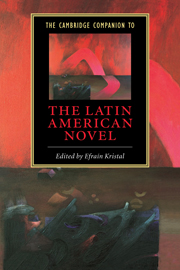Book contents
- Frontmatter
- Introduction
- Part I History
- Part II Heterogeneity
- Part III Gender and sexuality
- Part IV Six novels
- 11 Dom Casmurro by Machado de Assis
- 12 Pedro Páramo by Juan Rulfo
- 13 The Passion According to G.H. by Clarice Lispector
- 14 One Hundred Years of Solitude by Gabriel García Márquez
- 15 The House of the Spirits by Isabel Allende
- 16 The War of the End of the World by Mario Vargas Llosa
- Epilogue
- Bibliography
- Index
- Series List
11 - Dom Casmurro by Machado de Assis
from Part IV - Six novels
Published online by Cambridge University Press: 28 May 2006
- Frontmatter
- Introduction
- Part I History
- Part II Heterogeneity
- Part III Gender and sexuality
- Part IV Six novels
- 11 Dom Casmurro by Machado de Assis
- 12 Pedro Páramo by Juan Rulfo
- 13 The Passion According to G.H. by Clarice Lispector
- 14 One Hundred Years of Solitude by Gabriel García Márquez
- 15 The House of the Spirits by Isabel Allende
- 16 The War of the End of the World by Mario Vargas Llosa
- Epilogue
- Bibliography
- Index
- Series List
Summary
Dom Casmurro (1899), perhaps Brazil’s most celebrated novel, has acquired in the century since its publication what must be the longest critical bibliography devoted to any single work of Brazilian fiction. Part of its attraction no doubt lies in the enigma concerning possible adultery and betrayal that many critics have found in its pages. In the distinct stages the interpretation of the novel has gone through, betrayal has been the key issue of debate. Readings can be seen to organize themselves around the different answers to the questions of exactly who betrays whom, why, and to what end.
The third of the five major novels that Machado de Assis published between 1881 and 1908, Dom Casmurro is a retrospective first-person memoir - fictional, of course - told by an unreliable narrator. His perspective colors all elements of the narrative, subordinating them to his viewpoint. We have only Bento’s stubborn opinion of events and characters, which, however, his very text suggests may be different from what he makes them out to be. The “reality” the novel represents is radically subjectivized, nuanced, and complex, filtered by a problematic consciousness that ends up revealing perspectives other than the one he seems to intend. But while acknowledging this and other aspects of the novel that are in tune with modernism, we should also place it in the realist tradition where it also surely belongs. Recent critics, such as John Gledson and Roberto Schwarz, have argued persuasively for recognizing the novel’s keen understanding of class privilege and class relations in Brazilian society of the Second Reign (under Emperor Pedro II 1840-89).
- Type
- Chapter
- Information
- The Cambridge Companion to the Latin American Novel , pp. 219 - 231Publisher: Cambridge University PressPrint publication year: 2005
- 1
- Cited by



